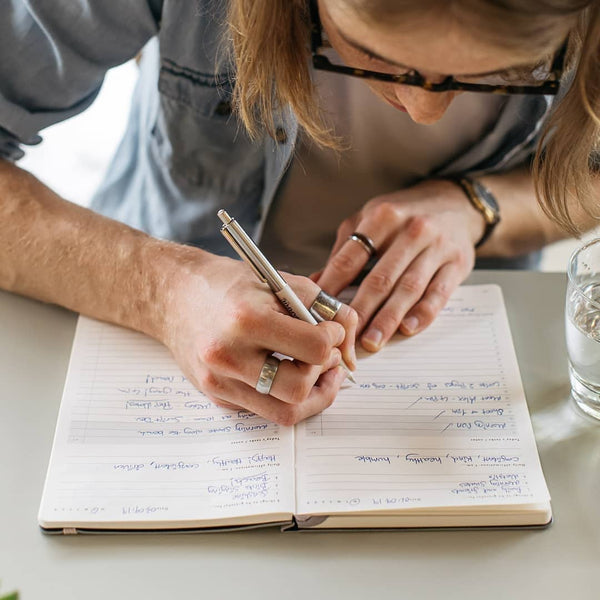Top 10 Tips for Using a Daily Planner
Most people rely on their smart devices to plan out their days. However, there’s something about writing things down that just makes them stick. If you’d like to rest your eyes from the glaring screens and plan your day with full clarity, all you need is a daily planner.
Nonetheless, beginners often find daily planners to be overwhelming. So, if you’d like to learn our top tips to make the most out of your daily planner, continue reading.
1. Schedule Daily Planning Sessions
Make it a daily habit to take time to sit down and plan out the next day. It’s actually quite helpful for your brain to do so because you’re not thinking or worrying about tomorrow while trying to fall asleep. When you’ve already planned out the day, your mind becomes clear.

2. Leave Your Planner Open All day
Most planner users underestimate the power of leaving their daily planners open or in an accessible place. When you leave it open, instead of putting it away after writing things down, it enables you to stay on top of things and be able to refer to it at all times.

3. Make Lists on Top of Lists
One of the most helpful aspects of daily planners is lists. We’re not just talking about to-do lists, which are essential. We’re talking about travel checklists, meal planners, grocery lists, repair logs, shopping lists, to-read, and to-watch lists, and the list, no pun intended, goes on.

4. Utilize Your Space to the Max
There are a lot of pages and spaces to utilise in a daily planner, and you can always customise and change things up.
Are there note pages and sidebars that you don’t know what to do with? Use them for a brain dump where you write everything down before you organize it. When you run out of space but still have more to write, get sticky notes.
You can also stay within the space but make even more use of it by applying a color-coding system or including icon stickers that help you know which task falls under which category at a glance.
Another hack to maximize existing space is to divide existing sections to suit your planning needs.

Empty Space Is Okay
This may sound like the opposite of utilizing your space, but it’s not. The stress to fill in every empty space in the planner is unreasonable when it has everything it needs to have. A daily planner’s job is to keep you productive. If it does its job, don’t burn yourself out by trying too hard to fill it.
5. Habit Tracking Is Key for Personal Improvement
If you have a daily planner but don’t track your habits, you’re missing out. Daily planners are the most helpful way to make a good habit stick or get rid of a bad habit. If your daily planner doesn’t already include a habit tracker, get an add-on or a printable one. The point is to employ the daily planner to truly improve your personal lifestyle.

6. Functionality Is More Important Than Aesthetics
There are tons of videos on Youtube and pictures on Instagram where daily planners look really pretty. A common beginner mistake is to overwhelm themselves with colors and decorative stickers to the point that it becomes hard to use the daily planner consistently. As a result, a lot of beginners end up giving up on planning.
While it’s nice to have an aesthetically pleasing planner, the point of a planner is in its name: to plan. Start your planning journey by being methodical. Once you get the hang of the basics and feel comfortable enough, spice things up with colored pens and stickers.

7. Time Block for Busy Schedules
Anyone that gets a daily planner is probably busy and wants to organize their tasks. However, some planner users are really busy and have a lot of tasks that they need to stay on top of. Others work from home and feel that their days are too structureless. They often ask themselves at the end of the day, “where did the time go?”
One of the best ways to improve productivity and make the most out of your day is to time block. This way, you’ll know exactly what you accomplished and how much time it took you to do each task.

8. Use One Planner for Everything
Some people have two planners: one for personal usage and another for business purposes. However, most people can do perfectly well with only one planner. In fact, having more than one planner can be overwhelming and distracting for most, which is the last thing a planner should do. So, keep everything in one planner and customize it to include all kinds of tasks.

9. Keep Track of Your Finances
Contrary to popular belief, planners aren’t just for daily habits. Everyone who earns or spends money could use some financial tracking.
Keep the due dates of your bills in sight in order not to miss a payment. Review how much you spend to be more mindful. Also, set financial goals and check them off when you achieve them.

10. Be Specific
A lot of people aren’t as specific as needed when planning to save space. For example, many would write “grandma” instead of “call grandma”. However, you’re actually more likely to do the task if you spell it out in full. If you’re trying to save space, try to minimize your handwriting instead.

Final Thoughts
As you can see, using a daily planner isn’t as complicated as it initially seems. You can use it to make lists, track habits and finances, block time, and so much more. The best thing about it is that you can customize how it looks and make it your own.


























